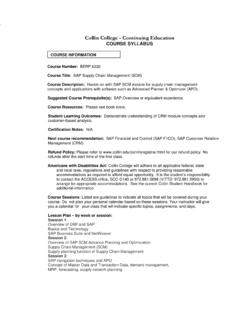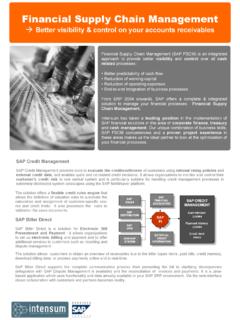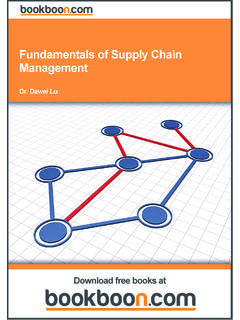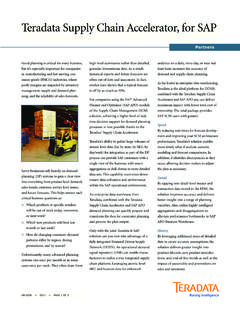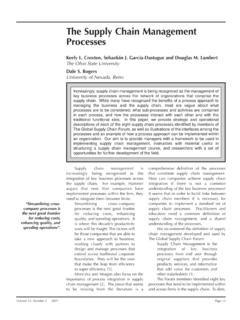Transcription of About the Tutorial
1 SAP SCM i About the Tutorial SAP supply chain management is one of the key modules in SAP ERP and controls Production Planning, business forecasting and demand planning. It helps the organization to manage their supply chain process in a dynamic environment. SAP SCM is a complete software to cover key processes such as supply chain networking, supply chain planning and coordination, and supply chain execution. Audience This Tutorial is meant for Project leaders, project team members, SAP consultants, sales consultant, and those related to the departments of planning and material management . Prerequisites Before you start proceeding with this Tutorial , we are assuming you have familiarity, prior experience, and knowledge of the domain of supply chain management . However, it is sufficient if you are aware of the basics of computer applications and SAP tools.
2 Copyright & Disclaimer Copyright 2018 by tutorials Point (I) Pvt. Ltd. All the content and graphics published in this e-book are the property of tutorials Point (I) Pvt. Ltd. The user of this e-book is prohibited to reuse, retain, copy, distribute, or republish any contents or a part of contents of this e-book in any manner without written consent of the publisher. We strive to update the contents of our website and tutorials as timely and as precisely as possible, however, the contents may contain inaccuracies or errors. tutorials Point (I) Pvt. Ltd. provides no guarantee regarding the accuracy, timeliness or completeness of our website or its contents including this Tutorial . If you discover any errors on our website or in this Tutorial , please notify us at SAP SCM ii Table of Contents About the Tutorial .. i Audience .. i Prerequisites .. i Copyright & Disclaimer.
3 I Table of Contents .. ii 1. SAP SCM Overview .. 1 2. SAP SCM Components .. 2 3. SAP SCM Benefits .. 4 4. SAP SCM Demand management .. 5 Planning Strategies .. 5 5. SAP SCM Creating PIR .. 7 Change and Delete PIR .. 8 6. SAP SCM Material Requirement Planning .. 10 MRP Parameters .. 10 Running MRP for all Products .. 11 MRP Evaluation Stock / Requirement List .. 15 SAP PP MRP List .. 16 7. SAP SCM Planned Order Creation .. 17 8. SAP SCM Production Order Creation .. 22 9. SAP SCM Goods Issue .. 25 Goods Issue Reversal .. 26 10. SAP SCM Production Order Confirmation .. 28 11. SAP SCM Production Order Cancellation .. 30 12. SAP SCM Integration .. 31 13. SAP SCM Integration Models .. 32 Activation and Deactivation of Integration Model .. 34 14. SAP SCM Master Data .. 37 Bills of Material (BOM) .. 37 Material Master .. 38 Work Center .. 39 Routing .. 40 15. SAP SCM Resources.
4 42 Resource Types .. 42 Create and Change Resources .. 43 SAP SCM iii 16. SAP SCM Production Data Structures .. 44 Production Data Structure in SAP APO .. 45 Production Data Structure in ERP .. 46 17. SAP SCM Transfer Changed Master Data .. 49 18. SAP SCM Transfer Changed BOMs .. 51 19. SAP SCM Model and Versions .. 53 Creating Model .. 54 Delete Model/Planning Version .. 57 20. SAP SCM Applications .. 60 21. SAP SCM Advanced Planning and Optimization APO .. 61 supply chain Monitoring .. 61 22. SAP SCM Extended Warehouse .. 63 Communication Method .. 63 SAP EWM Menu Structure .. 64 23. SAP SCM Transportation management .. 67 Custom Settings in APO .. 69 24. SAP SCM supply Network Collaboration .. 71 25. SAP SCM Forecasting & Replenishment .. 73 SAP F&R Administration .. 73 26. SAP SCM Consultant Responsibilities .. 75 SAP SCM 1 SAP supply chain management is one of the key modules in SAP ERP and controls Production Planning, business forecasting and demand planning.
5 The key features of SAP SCM are- It helps the organization to manage their supply chain process in a dynamic environment. SAP SCM process helps suppliers, customers, manufacturers, business partners and retailers connect with each other to manage supply chain process effectively and efficiently. It helps organizations to accelerate and optimize end-to-end procure-to-pay process. SCM products from SAP allows an organization to integrate their processes and enforce contract compliance for supply -side and supplier-side requirements throughout using supply chain processes in distributed environment. SAP SCM is a complete software to cover the key processes- supply chain networking, supply chain planning and coordination, and supply chain execution. It includes different planning applications related to Advanced Planning and Optimization APO, and for the integration with other SAP execution applications.
6 The primary applications are SAP General Areas, SAP supply Network Collaboration SNC, SAP Extended Warehouse management EWM, Advanced Planning and Optimization (APO), Forecasting and Replenishment FRE and SAP Transportation management TM. In the image shown below, you can see SAP supply chain management and its integration with other R/3 modules to manage supply chain process. 1. SAP SCM Overview SAP SCM 2 SAP supply chain management allows organizations to perform effective planning and execution of logistics within supply network and to perform workflow management . You can see the key steps in managing supply network in an organization. Each step consists of defined set of activities and hence helping customers, suppliers, and retailers connect with each other to provide an effective supply - chain - management solution. SAP SCM consists of the following components- SC Collaboration: This is used to help in making collaborative forecasts and agreements.
7 SC Planning: This is used to generate the operational plans as per current and relevant data in the system. SC coordination: This component in supply chain is used to coordinate the exchange of data and information between different business units. SC Execution: This is used to ensure that you execute the supply chain plans in the best possible manner to get the desired result. As per functionality, you can divide SCM/APO into three parts- Forecasting: To perform demand planning and forecasting, you can link to Customer Relationship management CRM to get data related to customer campaigns, etc. supply Network Planning (SNP): To view organization as a network of locations and to check stock projections and stock keeping criteria. Calculations in SNP drive dependent requirements down to supplying locations production and receiving stores.
8 Production Planning and Detailed Scheduling: This is to check the dependent requirements from locations within the supply network, passed down from SNP. 2. SAP SCM Components SAP SCM 3 This is linked with Material Requirement Planning (MRP) in Production Planning, which determines the inbound material required to complete a production order. SAP SCM 4 Using supply chain management in SAP, an organization can achieve the following benefits in a distributed environment- Reduce accounts receivable collections with better visibility into the AR process, aging, and extension of credit and consequently, help to reduce the day s sales outstanding. Effectively manage forecasting and handling sudden changes in demand and supply process. Effectively use Net Fixed assets NFA like plants and equipment. To meet customer demands, you can smartly plan and manage supply chain management process in an organization.
9 Proper inventory optimization, order fulfillment, and shipping of the goods. Distribution of the key information to all the stakeholders spread across the network. Improve communication and collaboration between different business lines to manage demand and supply process in an organization. Improve production efficiency and reduction in production quality issues and hence reduce cost of goods sold. To reduce transportation duties and taxes, and increase rebates and incentives. It also helps to reduce transportation errors. 3. SAP SCM Benefits SAP SCM 5 Demand management is used to forecast, manage, and plan the demands of goods and has defined set of processes and capabilities to produce goods. The key features of Demand management are- This component is used to improve the demand planning by utilizing promotions. Based on historical sales data, you can handle demand for every store, product from different customers and hence you can see customer responses as per change in pricing policies, and profit for a particular product in the organization.
10 You use demand models to predict consumers reaction with price change. As per organization goals like- increase profit, revenue, etc. you can define selling strategies for the products. In SAP PP system, demand management is performed by Planned Independent requirement PIR. Planned Independent Requirement provides input for production planning. A PIR contains one planned quantity of product and one date for material or a Planned quantity is split over a span of time period. To set your PIR version active use value 00 to specify requirement would be considered in material requirement planning. To maintain number of versions of planned independent requirement, you can set some numbers to active and others to inactive. PIRs define the planning strategy in material master, which determines planning methods- make to order and make to stock. In Make-to-Stock environment, PIRs are used where stock is built based on the forecast and not on sales order.










